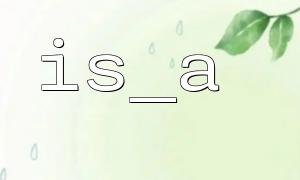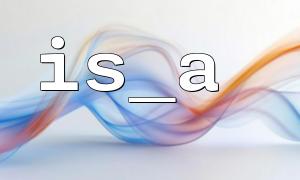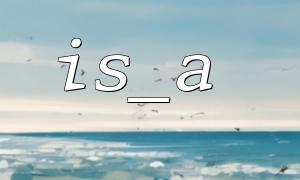When performing type detection in PHP, is_a() is a very practical function that can determine whether an object is an instance of a class, or whether it is a subclass of that class. However, using is_a() alone sometimes makes it difficult to deal with more complex scenarios, especially when we need to dynamically analyze the information of the class. At this time, using is_a() and ReflectionClass can greatly improve the flexibility and maintainability of the code.
The basic syntax of is_a() is as follows:
is_a(object|string $object_or_class, string $class, bool $allow_string = false): bool
To give a simple example:
class Animal {}
class Dog extends Animal {}
$dog = new Dog();
if (is_a($dog, Animal::class)) {
echo "yes Animal instance or subclass of";
}
In this example, is_a() determines whether $dog is an instance of Animal class or its subclass, and returns true .
ReflectionClass is part of the reflection mechanism provided by PHP, which allows us to get the details of the class at runtime. For example, we can list the interface, parent class, whether it is an abstract class, etc. implemented by a certain class.
$reflection = new ReflectionClass(Dog::class);
echo $reflection->getName(); // Output Dog
We can also get the parent class of the class:
$parent = $reflection->getParentClass();
if ($parent) {
echo "父kindyes:" . $parent->getName();
}
In more complex scenarios, we may need to first analyze the hierarchy of a class through reflection, and then use is_a() to make further judgments based on this. For example, the following code can dynamically load the class name and determine whether it is an implementation class of a certain interface:
function implementsInterface(string $className, string $interfaceName): bool {
if (!class_exists($className)) {
return false;
}
$reflection = new ReflectionClass($className);
return $reflection->implementsInterface($interfaceName);
}
The scenario combining is_a() is as follows:
function isInstanceOfClassOrSubclass($object, string $className): bool {
return is_a($object, $className);
}
Combined, we can write a general analysis function to conduct detailed inspections on the passed class or object:
function analyzeClass($input) {
$className = is_object($input) ? get_class($input) : $input;
if (!class_exists($className)) {
echo "kind {$className} Does not exist\n";
return;
}
$reflection = new ReflectionClass($className);
echo "kind名: " . $reflection->getName() . PHP_EOL;
if ($parent = $reflection->getParentClass()) {
echo "父kind: " . $parent->getName() . PHP_EOL;
}
$interfaces = $reflection->getInterfaceNames();
if ($interfaces) {
echo "Implemented interface: " . implode(", ", $interfaces) . PHP_EOL;
}
echo "yesno抽象kind: " . ($reflection->isAbstract() ? "yes" : "no") . PHP_EOL;
echo "yesno为指定kind型的子kind: " . (is_a($className, SomeBaseClass::class, true) ? "yes" : "no") . PHP_EOL;
}
Call example:
analyzeClass('m66.net\\UserController');
When developing plug-in systems or modular frameworks, it is often necessary to check whether a class implements a certain interface or inherits a certain base class. For example, a plugin must implement the PluginInterface interface before it can be loaded by the system:
$pluginClass = 'm66.net\\MyPlugin';
if (implementsInterface($pluginClass, 'm66.net\\PluginInterface')) {
$pluginInstance = new $pluginClass();
// Safe loading plugins
}
This pattern is extremely common in large applications, especially in frameworks, CMS or middleware architectures.
Using is_a() and ReflectionClass in combination can give PHP programs stronger dynamic type recognition capabilities. Especially in scenarios such as plug-in systems, dependency injection containers, automatic registration mechanisms, etc., this combination provides good scalability and flexibility, and is one of the indispensable tools for modern PHP development.













